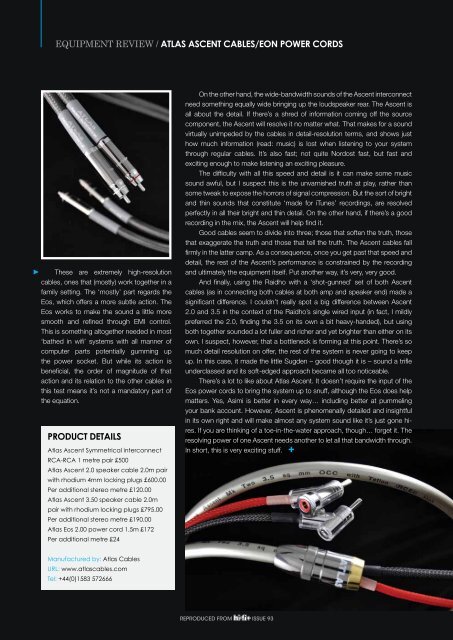Ascent Cables, HiFi Plus, Nov 2012 - Atlas Cables
Ascent Cables, HiFi Plus, Nov 2012 - Atlas Cables
Ascent Cables, HiFi Plus, Nov 2012 - Atlas Cables
Create successful ePaper yourself
Turn your PDF publications into a flip-book with our unique Google optimized e-Paper software.
EquipmEnt REviEw / AtlAs AscEnt cAblEs/Eon powEr cords<br />
These are extremely high-resolution<br />
cables, ones that (mostly) work together in a<br />
family setting. The ‘mostly’ part regards the<br />
Eos, which offers a more subtle action. The<br />
Eos works to make the sound a little more<br />
smooth and refined through EMI control.<br />
This is something altogether needed in most<br />
‘bathed in wifi’ systems with all manner of<br />
computer parts potentially gumming up<br />
the power socket. But while its action is<br />
beneficial, the order of magnitude of that<br />
action and its relation to the other cables in<br />
this test means it’s not a mandatory part of<br />
the equation.<br />
prodUct dEtAIls<br />
<strong>Atlas</strong> <strong>Ascent</strong> Symmetrical interconnect<br />
RCA-RCA 1 metre pair £500<br />
<strong>Atlas</strong> <strong>Ascent</strong> 2.0 speaker cable 2.0m pair<br />
with rhodium 4mm locking plugs £600.00<br />
Per additional stereo metre £120.00<br />
<strong>Atlas</strong> <strong>Ascent</strong> 3.50 speaker cable 2.0m<br />
pair with rhodium locking plugs £795.00<br />
Per additional stereo metre £190.00<br />
<strong>Atlas</strong> Eos 2.00 power cord 1.5m £172<br />
Per additional metre £24<br />
Manufactured by: <strong>Atlas</strong> <strong>Cables</strong><br />
URL: www.atlascables.com<br />
Tel: +44(0)1583 572666<br />
On the other hand, the wide-bandwidth sounds of the <strong>Ascent</strong> interconnect<br />
need something equally wide bringing up the loudspeaker rear. The <strong>Ascent</strong> is<br />
all about the detail. If there’s a shred of information coming off the source<br />
component, the <strong>Ascent</strong> will resolve it no matter what. That makes for a sound<br />
virtually unimpeded by the cables in detail-resolution terms, and shows just<br />
how much information (read: music) is lost when listening to your system<br />
through regular cables. It’s also fast; not quite Nordost fast, but fast and<br />
exciting enough to make listening an exciting pleasure.<br />
The difficulty with all this speed and detail is it can make some music<br />
sound awful, but I suspect this is the unvarnished truth at play, rather than<br />
some tweak to expose the horrors of signal compression. But the sort of bright<br />
and thin sounds that constitute ‘made for iTunes’ recordings, are resolved<br />
perfectly in all their bright and thin detail. On the other hand, if there’s a good<br />
recording in the mix, the <strong>Ascent</strong> will help find it.<br />
Good cables seem to divide into three; those that soften the truth, those<br />
that exaggerate the truth and those that tell the truth. The <strong>Ascent</strong> cables fall<br />
firmly in the latter camp. As a consequence, once you get past that speed and<br />
detail, the rest of the <strong>Ascent</strong>’s performance is constrained by the recording<br />
and ultimately the equipment itself. Put another way, it’s very, very good.<br />
And finally, using the Raidho with a ‘shot-gunned’ set of both <strong>Ascent</strong><br />
cables (as in connecting both cables at both amp and speaker end) made a<br />
significant difference. I couldn’t really spot a big difference between <strong>Ascent</strong><br />
2.0 and 3.5 in the context of the Raidho’s single wired input (in fact, I mildly<br />
preferred the 2.0, finding the 3.5 on its own a bit heavy-handed), but using<br />
both together sounded a lot fuller and richer and yet brighter than either on its<br />
own. I suspect, however, that a bottleneck is forming at this point. There’s so<br />
much detail resolution on offer, the rest of the system is never going to keep<br />
up. In this case, it made the little Sugden – good though it is – sound a trifle<br />
underclassed and its soft-edged approach became all too noticeable.<br />
There’s a lot to like about <strong>Atlas</strong> <strong>Ascent</strong>. It doesn’t require the input of the<br />
Eos power cords to bring the system up to snuff, although the Eos does help<br />
matters. Yes, Asimi is better in every way… including better at pummeling<br />
your bank account. However, <strong>Ascent</strong> is phenomenally detailed and insightful<br />
in its own right and will make almost any system sound like it’s just gone hires.<br />
If you are thinking of a toe-in-the-water approach, though… forget it. The<br />
resolving power of one <strong>Ascent</strong> needs another to let all that bandwidth through.<br />
In short, this is very exciting stuff.<br />
REPRODUCED FROM<br />
ISSUE 93<br />
+


